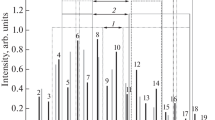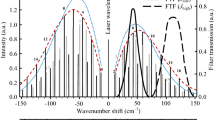Abstract
Calibration functions (CFs) are required for the pure rotational Raman (PRR) technique to retrieve atmospheric temperature profiles from raw lidar data. The accuracy of temperature retrievals essentially depends on the selected CF, especially in the troposphere where the molecular collision effect dominates over the Doppler one. In this paper, we theoretically and experimentally compare nine different CFs (five of which are suggested for the first time) to determine the best function for the tropospheric temperature retrievals. All the CFs represent special cases of the general CF that takes into account the collisional broadening of individual atmospheric N2 and O2 PRR lines. The comparative analysis of calibration errors ΔTerr produced using these CFs in a simulation study showed that the best CF among them gives |ΔTerr| < 4 × 10− 5 K. To determine the best CF from a practical standpoint, we apply all the functions to nighttime measurement data obtained in Tomsk (56.48°N, 85.05°E, Western Siberia, Russia) with a PRR lidar designed in the Institute of Monitoring of Climatic and Ecological Systems (IMCES). The CF best-suited for the tropospheric temperature measurements with the IMCES PRR lidar is the same as determined by simulation.














Similar content being viewed by others
References
P. Di Girolamo, R. Marchese, D.N. Whiteman, B.B. Demoz, Geophys. Res. Lett. 31, L01106 (2004)
M. Radlach, A. Behrendt, V. Wulfmeyer, Atmos. Chem. Phys. 8(2), 159 (2008)
R.K. Newsom, D.D. Turner, J.E.M. Goldsmith, J. Atmos. Ocean. Tech. 30(8), 1616 (2013)
P. Achtert, M. Khaplanov, F. Khosrawi, J. Gumbel, Atmos. Meas. Tech. 6(1), 91 (2013)
Y.J. Li, X. Lin, S.L. Song, Y. Yang, X.W. Cheng, Z.W. Chen, L.M. Liu, Y. Xia, J. Xiong, S.S. Gong, F.Q. Li, IEEE Trans. Geosci. Remote. Sens. 54(12), 7055 (2016)
Y.J. Li, X. Lin, Y. Yang, Y. Xia, J. Xiong, S.L. Song, L.M. Liu, Z.W. Chen, X.W. Cheng, F.Q. Li, J. Quant. Spectrosc. Radiat. Transf. 188(2), 94 (2017)
I. Balin, I. Serikov, S. Bobrovnikov, V. Simeonov, B. Calpini, Y. Arshinov, H. van den Bergh, Appl. Phys. B 79(6), 775 (2004)
S.Y. Chen, Z.J. Qiu, Y.C. Zhang, H. Chen, Y.Z. Wang, J. Quant. Spectrosc. Radiat. Transf. 112(2), 304 (2011)
J.Y. Jia, F. Yi, Appl. Opt. 53(24), 5330 (2014)
A. Behrendt, J. Reichardt, Appl. Opt. 39(9), 1372 (2000)
A. Behrendt, T. Nakamura, T. Tsuda, Appl. Opt. 43(14), 2930 (2004)
M. Fraczek, A. Behrendt, N. Schmitt, Appl. Opt. 51(2), 148 (2004)
E. Hammann, A. Behrendt, Opt. Express 23(24), 30767 (2015)
E. Hammann, A. Behrendt, F. Le Mounier, V. Wulfmeyer, Atmos. Chem. Phys. 15(5), 2867 (2015)
Y. Arshinov, S. Bobrovnikov, Appl. Opt. 38(21), 4635 (1999)
Y. Arshinov, S. Bobrovnikov, I. Serikov, A. Ansmann, U. Wandinger, D. Althausen, I. Mattis, D. Müller, Appl. Opt. 44(17), 3593 (2005)
D. Hua, M. Uchida, T. Kobayashi, Opt. Lett. 29(10), 1063 (2004)
A. Hauchecorne, P. Keckhut, J.-F. Mariscal, E. d’Almeida, P.-R. Dahoo, J. Porteneuve, EPJ Web of Conferences (ILRC 27) 119, 06008, (2016). https://doi.org/10.1051/epjconf/201611906008
S. Zhong, F. Yi, S.D. Zhang, Chin. J. Geophys. 55(6), 617 (2012)
A. Behrendt, T. Nakamura, M. Onishi, R. Baumgart, T. Tsuda, Appl. Opt. 41(36), 7657 (2002)
J. Su, M.P. McCormick, Y.H. Wu, R.B. Lee III, L.Q. Lei, Z.Y. Liu, K.R. Leavor, J. Quant. Spectrosc. Radiat. Transf. 125, 45 (2013)
A. Behrendt, in Temperature Measurements with Lidar, ed. by C. Weitkamp. Lidar, Range-Resolved Optical Remote Sensing of the Atmosphere (Springer, New York, 2005), pp. 273–305
Y.F. Arshinov, S.M. Bobrovnikov, V.E. Zuev, V.M. Mitev, Appl. Opt. 22(19), 2984 (1983)
D. Nedeljkovic, A. Hauchecorne, M.L. Chanin, IEEE Trans. Geosci. Remote Sens. 31(1), 90 (1993)
R.B. Lee III, Tropospheric temperature measurements using a rotational Raman lidar, PhD Dissertation, Ann Arbor, ProQuest LLC, 2013. https://pqdtopen.proquest.com/doc/1437652821.html?FMT=ABS. Accessed 13 June 2018
V.V. Gerasimov, V.V. Zuev, Opt. Express 24(5), 5136 (2016)
V.V. Zuev, V.V. Gerasimov, V.L. Pravdin, A.V. Pavlinskiy, D.P. Nakhtigalova, Atmos. Meas. Tech. 10(1), 315 (2017)
H. Chen, S.Y. Chen, Y.C. Zhang, P. Guo, H. Chen, B.L. Chen, Opt. Express 23(16), 21232 (2015)
H. Chen, S.Y. Chen, Y.C. Zhang, P. Guo, H. Chen, B.L. Chen, J. Geophys. Res. Atmos. 121(6), 2805 (2016)
J. Cooney, J. Appl. Meteorol. 11(1), 108 (1972)
I.D. Ivanova, L.L. Gurdev, V.M. Mitev, J. Mod. Opt. 40(3), 367 (1993)
V.V. Gerasimov, V.V. Zuev: Proc. SPIE 10006, 100060J (2016)
G. Martucci, V. Simeonov, L. Renaud, A. Haefele, EPJ Web Conf. (ILRC 28) 176, 01017 (2018). https://doi.org/10.1051/epjconf/201817601017
D. Wu, Z. Wang, P. Wechsler, N. Mahon, M. Deng, B. Glover, M. Burkhart, W. Kuestner, B. Heesen, Opt. Express 24(18), A1210 (2016)
A.V. El’nikov, V.V. Zuev, S.L. Bondarenko, Atmos. Ocean. Opt. 13(12), 1029 (2000)
Author information
Authors and Affiliations
Corresponding author
Ethics declarations
Conflict of interest
The author declares that he has no conflict of interest.
Electronic supplementary material
Below is the link to the electronic supplementary material.
Appendix: Absolute and relative uncertainties of temperature retrieval
Appendix: Absolute and relative uncertainties of temperature retrieval
Assuming Poisson statistics of photon counting, the 1–σ absolute statistical uncertainty ΔT of indirect temperature measurements is written in the following general form [22]:
where T = T(Q) can be determined by any selected TRF (e.g., by any one of the nine TRFs considered in Sects. 3 and 4); Q = NL/NH is the ratio of background-subtracted photocounts NL and NH detected by PMTs in the Jlow and Jhigh lidar channels, respectively. In practice, however, raw measurement data are usually averaged to improve the signal-to-noise ratio and reduce statistical uncertainties. The absolute uncertainty of air temperature retrievals from single-averaged photocounts \({\overline {N} _{\text{H}}}\) and \({\overline {N} _{\text{L}}}\) decreases \(\sqrt n\) times [27]:
where \(Q = \overline{N}_{{\text{L}}} {\text{ /}}\overline{N}_{{\text{H}}}\) and n is the variable (or constant) sliding window size, i.e., the number of raw lidar data points determining the sliding window length (data resolution) after averaging \(\Delta \overline {z} =n\Delta z\) with the initial vertical resolution of Δz (see Sect. 6.2). If n varies with altitude z (i.e., in the case of a variable sliding window), the uncertainty \(\Delta \overline {T}\) should be estimated separately for each altitude interval where n = const.
In certain circumstances, despite a decrease in vertical resolution, the second-order averaging of raw data can be more preferable and useful than the first-order one [27, 35]. There are two ways to average previously averaged PRR lidar data. The first way is to average the ratio \(Q = \overline{N}_{{\text{L}}} {\text{ /}}{\mkern 1mu} \overline{N}_{{\text{H}}}\) of single-averaged photocounts \({\overline {N} _{\text{H}}}\) and \({\overline {N} _{\text{L}}}\), i.e., to obtain the averaged ratio \(Q_{{\text{I}}} = \overline{Q} = \overline{{\overline{N}_{{\text{L}}} {\text{ /}}\overline{N}_{{\text{H}}} }}\). The second way is to average \({\overline {N}_H}\) and \({\overline {N}_L}\) to obtain the ratio of double-averaged photocounts \({\overline{\overline {N}} _{\text{H}}}\) and \({\overline{\overline {N}} _{\text{L}}}\), i.e., In both cases, the absolute uncertainty decreases \(\sqrt {nm}\) times, i.e., \(\Delta \overline{\overline{T}} = \Delta T{\text{ /}}\sqrt {n{\mkern 1mu} m}\), where m is the sliding window size of the second-order averaging [27]. For the first way of the second-order averaging that we use in our study, the absolute and relative uncertainties of temperature retrievals are determined by
1.1 Three-coefficient special cases of Eq. (4)
Here we present the absolute and relative uncertainties of temperature retrievals with the use of TRFs 1–4 considered in Sects. 3.1 and 3.2. Both statistical uncertainties for these functions were obtained in an analytical form in [27]. For the case of TRF 1 (see Eq. (12)), we have:
where T are the retrieved temperature profile points that can be found in the electronic supplementary material.
When applying TRF 2 [see Eq. (14)] for temperature retrievals, the uncertainties are given by:
In the case of TRF 3 [see Eq. (16)], the corresponding uncertainties can be calculated by:
where QI are the photocount ratio points (Supplementary material) obtained by the second-order averaging procedure explained above and in [27] in detail.
Finally, for TRF 4 given by Eq. (18), the uncertainties are of the following forms:
1.2 Three-coefficient special cases of Eq. (3)
In this Appendix we consider the absolute and relative uncertainties when using TRFs 5 and 6 presented in Sect. 3.3. To obtain the uncertainties (in an analytical form) produced using any TRF, we need to differentiate the corresponding function (see Eqs. (41) and (42)). The first-order derivative of TRF 5 (see Eq. (20)) is
The expression of the derivative is cumbersome and makes it difficult to use Eqs. (41) and (42) in calculating the uncertainties. Nevertheless, it is easy to put Eq. (51) in a more convenient form using the expressions resulting from Eq. (20):
After substitution of Eqs. (52) into Eq. (51), the derivative becomes:
As a result, we can write the absolute uncertainty in an easy-to-use form:
and for the relative uncertainty we have
Similarly, the first-order derivative of TRF 6 (see Eq. (22)) is defined by
The derivative can be written in a more simple form through the use of the expressions that follow from Eqs. (22) and (21), respectively:
After substitution of Eqs. (57) into Eq. (56), for the derivative we get:
Substituting the derivative into Eqs. (41) and (42), we obtain analytical expressions for the uncertainties:
1.3 Four-coefficient special cases of Eq. (4)
Here we derive formulae for both statistical uncertainties for the case of TRFs 7–9 obtained in Sect. 4.2. The first-order derivative of TRF 7 (see Eq. (34)) is written as:
The denominator of the derivative can be simplified by the expression following from Eq. (34):
This finally leads to the subsequent analytical expressions of the uncertainties:
In the case of TRF 8 (see Eq. (36)), for the first-order derivative we have:
Similarly, the derivative can be simplified by the expression obtained from Eq. (36)
Substituting Eq. (66) into Eq. (65) and then Eq. (65) into Eq. (41) and (42), for the uncertainties we get:
Finally, we find for the first-order derivative of TRF 9 (see Eq. (38)):
The use of the expression resulting from Eq. (38)
gives the following absolute and relative uncertainties:
Rights and permissions
About this article
Cite this article
Gerasimov, V.V. Comparative analysis of calibration functions in the pure rotational Raman lidar technique. Appl. Phys. B 124, 134 (2018). https://doi.org/10.1007/s00340-018-7004-z
Received:
Accepted:
Published:
DOI: https://doi.org/10.1007/s00340-018-7004-z




